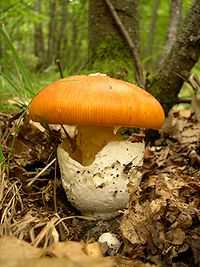Volva (mycology)

The volva is a mycological term to describe a cup-like structure at the base of a mushroom that is a remnant of the universal veil,[1] or the remains of the peridium that encloses the immature fruit bodies of gasteroid fungi.[2] This macrofeature is important in wild mushroom identification because it is an easily observed, taxonomically significant feature that frequently signifies a member of Amanitaceae. This has particular importance due to the disproportionately high number of deadly poisonous species contained within that family.
A mushroom's volva is often partially, or completely buried in the ground, and therefore care must be taken to check for its presence when identifying mushrooms.[3] Cutting or pulling mushrooms and attempting to identify them later without having noted this feature could lead to a fatal error.
References
- ↑ Kirk PM, Cannon PF, Minter DW, Stalpers JA. (2008). Dictionary of the Fungi (10th ed.). Wallingford, UK: CAB International. p. 727. ISBN 978-0-85199-826-8.
- ↑ Miller HR, Miller OK. (1988). Gasteromycetes: Morphological and Developmental Features, with Keys to the Orders, Families, and Genera. Eureka, California: Mad River Press. p. 133. ISBN 0-916422-74-7.
- ↑ Kuo M. (2007). 100 Edible Mushrooms. Ann Arbor, Michigan: The University of Michigan Press. p. 45. ISBN 0-472-03126-0.